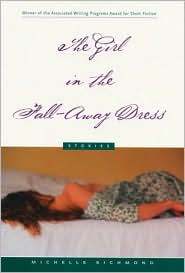Now available: The Girl in the Fall-Away Dress
 The Girl in the Fall-Away Dress, originally published in 2001 by the University of Massachusetts Press and winner of the AWP Award for Short Fiction, is now available for Nook, Kindle, and other ereaders.
The Girl in the Fall-Away Dress, originally published in 2001 by the University of Massachusetts Press and winner of the AWP Award for Short Fiction, is now available for Nook, Kindle, and other ereaders.
“The stories in Michelle Richmond’s first collection spin artfully off the life of a single character…smart and adept…” The New York Times
“This collection of brief sketches alternating with longer fictions has a novel’s heft, as characters who are just names in one story emerge to take center stage in another. These women’s lives are shaped by fate and by place, forces hauntingly evoked by this talented young writer.” ~The Boston Globe
“Richmond’s writing is perceptive and heartfelt, her subjects at once edgy and familiar. This is a winning debut.” Publishers Weekly
The New York Times Book Review:
The stories in Michelle Richmond’s first collection spin artfully off the life of a single character. Gracie is nearly 30 when we first meet her, sitting in a rented car on the way to the Jersey Shore and just about to break up with her Bruce Springsteen-obsessed boyfriend. Most of the stories circle similar small, critical moments. In the crushingly sweet and brief ”Curvature,” for example, Gracie stands in the doorway of her sister Celia’s bedroom and watches her mother dress the wound on Celia’s back, made by surgery to correct curvature of the spine. A child at the time, Gracie envies the intimacy between her mother and sister and, in those few minutes, recognizes her mother’s capacity for sacrifice and tenderness. In ”Mathematics and Acrobatics,” set years later, Celia and her young daughter, Roberta, witness a bus accident on an icy Georgia road. Celia doesn’t stop to help the victims, and Roberta’s insensitive reaction to the scene makes Celia question both her mothering abilities and her own response to the crash. The settings here — from the Alabama coast to Iceland — frequently shift, as does the perspective; there are stories from the point of view of each of Gracie’s three sisters and a few of her childhood friends…smart and adept.”
About THE GIRL IN THE FALL-AWAY DRESS
A series of locations both familiar and exotic delineate the nineteen linked stories in this award-winning debut collection. Whether leaving, returning, or staying put, the women who narrate these stories are bound to Alabama by history and habit, their voices informed by the landscape and lore of the New South.
Michelle Richmond introduces us to a memorable extended family, in which lies come more easily than forgiveness, and parents and siblings conceal the truth as often as they reveal it. In many cases, the women are forced to choose—between family and lovers, safety and self-sufficiency, the religion they grew up with and the reality of the world they have found for themselves.
In “Down the Shore Everything’s All Right,” twenty-eight-year-old Grace abandons wide Southern beaches for New York sidewalks, only to discover that the Gulf Coast still has a hold on her. In “Intermittent Waves of Unusual Size and Force,” a wayward father is called home from California by a massive hurricane that threatens the lives of his family. In “The World’s Greatest Pants,” three younger sisters watch in awe as Darlene, the eldest and bravest, defies her parents and heads for Texas in a battered El Camino.
An undercurrent of eroticism runs through the collection. “Propaganda” finds the youngest sister alone in an old house in Knoxville, where she forms a symbiotic relationship with a mysterious upstairs neighbor during her husband’s lengthy absence. In “Fifth Grade: A Criminal History,” adolescence and sexuality merge with explosive consequences. A woman dancing naked on a bridge in San Francisco is the central figure of the title story.
The divine and the absurd are uneasy but frequent bedfellows in this volume. “O-lama-lama” portrays the scene of a religious free-for-all at a beachside church in Fairhope, Alabama, while “Slacabamorinico” celebrates the holy commotion of Mardi Gras at a Mobile cemetery. In “The Last Bad Thing,” a love-struck young woman in the Bible Belt is haunted by visions of Ramadan.
 Has it really been ten years since I walked down the aisle at the little chapel in Yosemite, tripped on my dress, married that boy I met in Arkansas, went a bit too far with the tequila, and spent all night in our room at the Wawona Hotel searching for ghosts in the closet? It has!
Has it really been ten years since I walked down the aisle at the little chapel in Yosemite, tripped on my dress, married that boy I met in Arkansas, went a bit too far with the tequila, and spent all night in our room at the Wawona Hotel searching for ghosts in the closet? It has!
